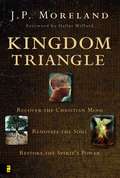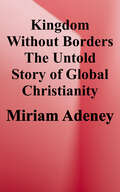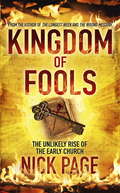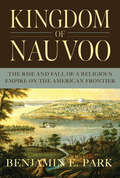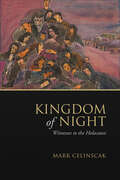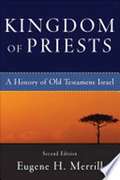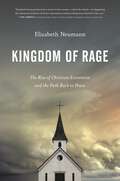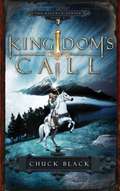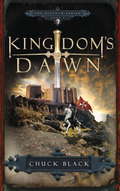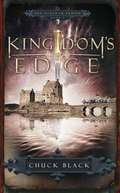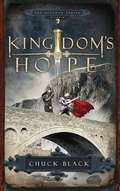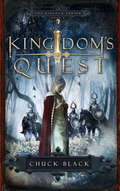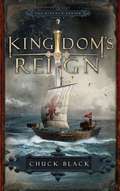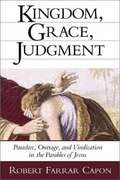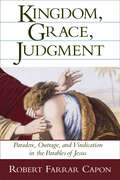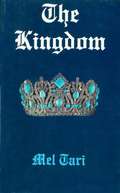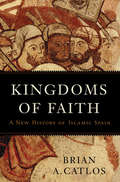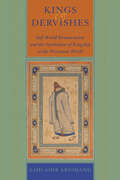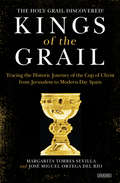- Table View
- List View
Kingdom Triangle
by J. P. MorelandWestern society is in crisis, the result of our culture's embrace of naturalism and postmodernism. At the same time, the biblical worldview has been pushed to the margins. Christians have been strongly influenced by these trends, with the result that the personal lives of Christians often reflect the surrounding culture more than the way of Christ, and the church's transforming influence on society has waned. In Kingdom Triangle, J. P. Moreland issues a call to recapture the drama and power of kingdom living. He examines and provides a penetrating critique of these worldviews and shows how they have ushered in the current societal crisis. He then lays out a strategy for the Christian community to regain the potency of kingdom life and influence in the world. Drawing insights from the early church, he outlines three essential ingredients of this revolution: ? Recovery of the Christian mind ? Renovation of Christian spirituality ? Restoration of the power of the Holy Spirit He believes that evangelical Christianity can mature and lead the surrounding society out of the meaningless morass it finds itself in with humility and vision.
Kingdom Triangle: Recover the Christian Mind, Renovate the Soul, Restore the Spirit's Power
by J. P. MorelandWestern society is in crisis, the result of our culture's embrace of naturalism and postmodernism. At the same time, the biblical worldview has been pushed to the margins. Christians have been strongly influenced by these trends, with the result that the personal lives of Christians often reflect the surrounding culture more than the way of Christ, and the church's transforming influence on society has waned. In Kingdom Triangle, J.P. Moreland issues a call to recapture the drama and power of kingdom living. He examines and provides a penetrating critique of these worldviews and shows how they have ushered in the current societal crisis. He then lays out a strategy for the Christian community to regain the potency of kingdom life and influence in the world. Drawing insights from the early church, he outlines three essential ingredients of this revolution: ? Recovery of the Christian mind ? Renovation of Christian spirituality ? Restoration of the power of the Holy Spirit He believes that evangelical Christianity can mature and lead the surrounding society out of the meaningless morass it finds itself in with humility and vision.
Kingdom Triangle: Recover the Christian Mind, Renovate the Soul, Restore the Spirit's Power
by J. P. MorelandJ.P. Moreland—Christian philosopher, theologian, and apologist—issues a call to recapture the drama and power of kingdom living—to cultivate a revolution of Evangelical life, spirituality, thought, and Spirit-led power.Drawing insights from the early church, he unpacks three essential ingredients of this revolution:Recovery of the Christian mind.Renovation of Christian spirituality.Restoration of the power of the Holy Spirit.Western society is in crisis: the result of our culture's embrace of naturalism and postmodernism, and a biblical worldview has been pushed to the margins. Christians have been strongly influenced by these trends, with the result that their personal lives often reflect the surrounding culture more than the way of Christ, and the church's transforming influence on society has waned as a result.Kingdom Triangle is divided into two major sections:The first examines and provides a critique of secular worldviews and shows how they have ushered in the current societal crisis.The second lays out a strategy for the Christian community to regain the potency of kingdom life and influence in the world.Moreland believes that evangelical Christianity can mature and lead the surrounding society out of the meaningless morass it finds itself in with humility and vision. With clear insight, he puts the thoughtful Christian in a position to understand our current cultural struggle and to return to a responsible presentation of "the way of Christ" as not just a way of right living, but also a way of knowledge and meaningful life.
Kingdom Without Borders: The Untold Story of Global Christianity
by Miriam AdeneyThe twenty-first century has opened with a rapidly changing map of Christianity. While its influence is waning in some of its traditional Western strongholds, it is growing at a phenomenal pace in the global South. And yet this story has largely eluded the corporate news brokers of the West. Layered as it is with countless personal and corporate stories of remarkable faith and witness, it nevertheless lies ghostlike behind the newsprint and webpages of our print media, outside the camera's vision on the network evening news.Miriam Adeney has lived, traveled and ministered widely. She has walked with Christians in and from the far reaches of the globe. As she pulls back the veil on real Christians--their faith, their hardships, their triumphs and, yes, their failures--an inspiring and challenging story of a kingdom that knows no borders takes shape.This is a book that coaxes us out of our comfortable lives. It beckons us to expand our vision and experience of the possibilities and promise of a faith that continues to shape lives, communities and nations.
Kingdom of Fools: The Unlikely Rise of the Early Church
by Nick PageFools. Rebels. Ignorant peasants.That's how the Roman world saw the first Christians. Led by fishermen, tax collectors and renegade Pharisees, the first Christians shunned power and welcomed the poor and uneducated. Roman commentators mocked their upside-down values, but the apostle Paul - himself a Roman citizen, and a Pharisee to boot, affirmed that 'God chose what is foolish in the world to shame the wise.'Its followers were persecuted and its leaders killed, yet this ragged collection of lowly tradesmen, women, slaves - and a smattering of turncoat high-born Jews - created a movement that changed the world. How did this happen? How did the kingdom of fools conquer the mighty empire that was Rome?In this fascinating new biography of the early church, Nick Page sets the biblical accounts alongside the latest historical and archaeological research, exploring how the early Christians lived and worshipped - and just why the Romans found this new branch of the Jewish faith so difficult to comprehend.THE KINGDOM OF FOOLS is a fresh, challenging, accessible portrait of a movement so radical, so dangerous, so thrillingly different that it outlasted the empire that tried to destroy it and went on to become the driving force of our cultural development - and claims more followers today than ever before in history.
Kingdom of Fools: The Unlikely Rise of the Early Church
by Nick PageFools. Rebels. Ignorant peasants.That's how the Roman world saw the first Christians. Led by fishermen, tax collectors and renegade Pharisees, the first Christians shunned power and welcomed the poor and uneducated. Roman commentators mocked their upside-down values, but the apostle Paul - himself a Roman citizen, and a Pharisee to boot, affirmed that 'God chose what is foolish in the world to shame the wise.'Its followers were persecuted and its leaders killed, yet this ragged collection of lowly tradesmen, women, slaves - and a smattering of turncoat high-born Jews - created a movement that changed the world. How did this happen? How did the kingdom of fools conquer the mighty empire that was Rome?In this fascinating new biography of the early church, Nick Page sets the biblical accounts alongside the latest historical and archaeological research, exploring how the early Christians lived and worshipped - and just why the Romans found this new branch of the Jewish faith so difficult to comprehend.THE KINGDOM OF FOOLS is a fresh, challenging, accessible portrait of a movement so radical, so dangerous, so thrillingly different that it outlasted the empire that tried to destroy it and went on to become the driving force of our cultural development - and claims more followers today than ever before in history.
Kingdom of Nauvoo: The Rise And Fall Of A Religious Empire On The American Frontier
by Benjamin E. ParkAn extraordinary story of faith and violence in nineteenth-century America, based on previously confidential documents from the Church of Jesus Christ of Latter-day Saints. Compared to the Puritans, Mormons have rarely gotten their due, treated as fringe cultists at best or marginalized as polygamists unworthy of serious examination at worst. In Kingdom of Nauvoo, the historian Benjamin E. Park excavates the brief life of a lost Mormon city, and in the process demonstrates that the Mormons are, in fact, essential to understanding American history writ large. Drawing on newly available sources from the LDS Church—sources that had been kept unseen in Church archives for 150 years—Park recreates one of the most dramatic episodes of the 19th century frontier. Founded in Western Illinois in 1839 by the Mormon prophet Joseph Smith and his followers, Nauvoo initially served as a haven from mob attacks the Mormons had endured in neighboring Missouri, where, in one incident, seventeen men, women, and children were massacred, and where the governor declared that all Mormons should be exterminated. In the relative safety of Nauvoo, situated on a hill and protected on three sides by the Mississippi River, the industrious Mormons quickly built a religious empire; at its peak, the city surpassed Chicago in population, with more than 12,000 inhabitants. The Mormons founded their own army, with Smith as its general; established their own courts; and went so far as to write their own constitution, in which they declared that there could be no separation of church and state, and that the world was to be ruled by Mormon priests. This experiment in religious utopia, however, began to unravel when gentiles in the countryside around Nauvoo heard rumors of a new Mormon marital practice. More than any previous work, Kingdom of Nauvoo pieces together the haphazard and surprising emergence of Mormon polygamy, and reveals that most Mormons were not participants themselves, though they too heard the rumors, which said that Joseph Smith and other married Church officials had been “sealed” to multiple women. Evidence of polygamy soon became undeniable, and non-Mormons reacted with horror, as did many Mormons—including Joseph Smith’s first wife, Emma Smith, a strong-willed woman who resisted the strictures of her deeply patriarchal community and attempted to save her Church, and family, even when it meant opposing her husband and prophet. A raucous, violent, character-driven story, Kingdom of Nauvoo raises many of the central questions of American history, and even serves as a parable for the American present. How far does religious freedom extend? Can religious and other minority groups survive in a democracy where the majority dictates the law of the land? The Mormons of Nauvoo, who initially believed in the promise of American democracy, would become its strongest critics. Throughout his absorbing chronicle, Park shows the many ways in which the Mormons were representative of their era, and in doing so elevates nineteenth century Mormon history into the American mainstream.
Kingdom of Night: Witnesses to the Holocaust
by Mark CelinscakIn April 1945, when the Bergen-Belsen concentration camp was surrendered and handed over to the British Army, Canadian forces arrived on scene to provide support, to bear witness, and to document the crimes. They were overwhelmed, understaffed, and left without adequate supplies, equipment, and medicine. Their encounters at the camp were haunting, transformative experiences that forever changed their lives. In Kingdom of Night, Mark Celinscak reveals the engagement of Canadian troops and other personnel at the Bergen-Belsen concentration camp. The book brings together a series of gripping, often deeply moving accounts that demonstrate the critical relief work carried out by Canadians who have been largely overlooked for more than seventy-five years. It outlines in both stark and moving detail what a cross-section of Canadians both said and did during the liberation efforts at one of the most notorious sites in Hitler’s camp system. In addition, biographical overviews are presented for each Canadian featured in the book, not only highlighting some of their life-saving and humanitarian work, but also revealing what ultimately became of their lives after the war. Kingdom of Night depicts the gruelling efforts by those who assisted the victims of one of the greatest crimes in history.
Kingdom of Priests: A History of Old Testament Israel
by Eugene H. MerrillFrom the origins and exodus to the restoration and new hope, Kingdom of Priests offers a comprehensive introduction to the history of Old Testament Israel. Merrill explores the history of ancient Israel not only from Old Testament texts but also from the literary and archeological sources of the ancient Near East. After selling more than 30,000 copies, the book has now been updated and revised. The second edition addresses and interacts with current debates in the history of ancient Israel, offering an up-to-date articulation of a conservative evangelical position on historical matters. The text is accented with nearly twenty maps and charts.
Kingdom of Rage: The Rise of Christian Extremism and the Path Back to Peace
by Elizabeth NeumannA former counterterrorism official explores how modern evangelicalism and right-wing conservatism intermingled to form the combustible ideology that resulted in the January 6 attacks on the Capitol—and which threatens to destroy the American Church from within. How did a Church that purports to follow the teachings of Jesus - the Prince of Peace - become a breeding ground for violent extremism? When Elizabeth Neumann began her anti-terrorism career as part of President George W. Bush&’s Homeland Security Counsel in the wake of the September 11 attacks, she expected to spend her life protecting her country from the threat of global terrorism. But as her career evolved, she began to perceive that the greatest threat to American security came not from religious fundamentalists in Afghanistan or Iraq but from white nationalists and radicalized religious fundamentalists within the very institution that was closest to her heart – the American evangelical church. And she began to sound the alarm, raising her concerns to anyone in government who would listen, including testifying before Congress in February of 2020. At that time, Neumann warned that anti-Semitic and white supremacist terrorism was a transnational threat that was building to the doorstep of another major attack. Shortly after her testimony, she resigned from her role as Department of Homeland Security Assistant Secretary for Counterterrorism and Threat Prevention in protest of what she believed was then-President Trump&’s failure of leadership and his stoking of the hatred, anger, and division from which she had dedicated her life to protecting her country. Her worst fears came true when she witnessed the attack on the capital on January 6, 2021. In Kingdom of Rage, Neumann explores the forces within American society that have encouraged the radicalization of white supremacist, anti-government and other far-right terrorists by co-opting Christian symbols and culture and perverting the faith&’s teachings. While Neumann offers decades of insights into the role government policies can play to prevent further bloodshed, she believes real change must come from the within the Christian church. She shines a bright light on the responsibility of ordinary Americans – and particularly American Christians – to work within their families and their communities to counteract the narrative of victimization and marginalization within American evangelicalism. Her goal for this book is not only to sound a warning about one of the greatest threats to our security but to rescue the Church from the forces that will, if left unchecked, destroy it – culturally, morally, and ultimately quite literally. This is a book for anyone who wants to understand the unholy marriage of right-wing politics and Christian exceptionalism in America and who wants to be a part of reversing the current path towards division, hatred, violence and the ultimate undermining of both evangelical Christianity and American democracy.
Kingdom to Commune: Protestant Pacifist Culture between World War I and the Vietnam Era
by Patricia AppelbaumAmerican religious pacifism is usually explained in terms of its practitioners' ethical and philosophical commitments. Patricia Appelbaum argues that Protestant pacifism, which constituted the religious center of the large-scale peace movement in the United States after World War I, is best understood as a culture that developed dynamically in the broader context of American religious, historical, and social currents. Exploring piety, practice, and material religion, Appelbaum describes a surprisingly complex culture of Protestant pacifism expressed through social networks, iconography, vernacular theology, individual spiritual practice, storytelling, identity rituals, and cooperative living. Between World War I and the Vietnam War, she contends, a paradigm shift took place in the Protestant pacifist movement. Pacifism moved from a mainstream position to a sectarian and marginal one, from an embrace of modernity to skepticism about it, and from a Christian center to a purely pacifist one, with an informal, flexible theology. The book begins and ends with biographical profiles of two very different pacifists, Harold Gray and Marjorie Swann. Their stories distill the changing religious culture of American pacifism revealed inKingdom to Commune.
Kingdom's Call (Kingdom Series #4)
by Chuck BlackA sworn enemy of the Prince vows to eliminate his Followers.Until the Prince saves his life...For generations the Noble Knights have been in service to the King. Following a strict code of conduct, they preserve the peace in Chessington, the King's chosen city, and rule its citizenry. Sir Gavin is a young and promising Noble Knight, devoted to King and Code.Then a peasant disrupts the tranquility of Chessington, brazenly challenging the Code while claiming to be the son of the King-a Prince. When it is learned that he is actively training a force of men in defiance of the law, the stranger is arrested and executed.But his Followers continue to defy the Code, and Sir Gavin swears to destroy this threat to Chessington-until he himself is grievously wounded in battle. As he faces his own death, Gavin is saved by someone who will transform his heart and change his life...Journey to Arrethtrae, where the King and His Son implement a bold plan to save their kingdom; where courage, faith, and loyalty stand tall in the face of opposition; where good will not bow to evil-and one brave man stands against the Dark Knight.From the Trade Paperback edition.
Kingdom's Dawn (Kingdom Series #1)
by Chuck BlackA Riveting Medieval Parallel to the Bible Good and evil clash. Leinad and Cedric are determined to not only survive, but claim hope and victory! In Kingdom's Dawn, Leinad and Tess, along with all the king's people, must escape slavery by the powerful Lord Fairos. Kingdom's Hope finds them free and arriving in the Chessington Valley. But when they forget the king, will Kergon and the Kessons capture them for good? After many years, Kingdom's Edge finds Cedric living a hopeless life until a stranger appears with powerful words of a new kingdom and a grand army. Finally, Kingdom's Reign marches you through the danger of earth's last days as the evil dark knight threatens to defeat the prince once and for all. Swords, knights, and battles define these captivating tales that parallel biblical events from Genesis to Revelation! He's just a young man, but that doesn't change the truth. He was chosen... Sixteen-year-old Leinad thought he was a common farmer's son, nothing more. He wondered why his father had trained him for years to master the sword--not exactly a tool of the trade for farmers--but one tragic event initiates a world of revelation. Only then does he begin to understand his calling--a calling no other man in the entire kingdom of Arrethtrae can fulfill--a calling given him by the King himself. Teamed with a young slave girl, Leinad is thrust into adversity and danger--for the Dark Knight and his vicious Shadow Warriors will stop at nothing to thwart the King's plan to restore the kingdom. Leinad will need more than a sharp blade and a swift hand to fulfill his mission and survive the evil plots of the King's sworn enemies! Journey to Arrethtrae, where the King and His Son implement a bold plan to save their kingdom; where courage, faith, and loyalty stand tall in the face of opposition; where good will not bow to evil--and the future of a kingdom lies in the hands of a young man. DISCUSSION QUESTIONS INCLUDED Story Behind the Book"When my six kids' eyes glossed over during a reading from the Bible, I paused to explain the significance of redemption to a sin-sick soul. I was rewarded with patronizing elephant nods and more blank stares. Shortly thereafter, I awoke in the middle of the night with a medieval story enveloping my mind. I wrote it down and later read it to my children. Their waning attention transformed into complete anticipation. I was amazed and disappointed. Why did it take a fictional story, not a Bible passage, to get that response? Then I realized--that is how Jesus taught! Parables are powerful! I penned the Kingdom series to help young people get excited about the supremely significant story of Jesus Christ and His mission to save mankind." -- Chuck BlackFrom the Trade Paperback edition.
Kingdom's Edge (Kingdom Series #3)
by Chuck BlackA Riveting Medieval Parallel to the Bible Good and evil clash. Leinad and Cedric are determined to not only survive, but claim hope and victory! In Kingdom's Dawn , Leinad and Tess, along with all the king's people, must escape slavery by the powerful Lord Fairos. Kingdom's Hope finds them free and arriving in the Chessington Valley . But when they forget the king, will Kergon and the Kessons capture them for good? After many years, Kingdom's Edge finds Cedric living a hopeless life until a stranger appears with powerful words of a new kingdom and a grand army. Finally, Kingdom's Reign marches you through the danger of earth's last days as the evil dark knight threatens to defeat the prince once and for all. Swords, knights, and battles define these captivating tales that parallel biblical events from Genesis to Revelation! He was doomed to a life of hopelessness and despair. Then the stranger arrived... For Cedric of Chessington, every day is the same: full of poverty and despair. And he knows that will never change. Or so he thinks. Then a stranger comes to the city. Drawn to the man's mysterious ways, Cedric discovers the stranger's humility belies great strength and wisdom. That's when an astounding truth becomes clear--the stranger is a Master of the Sword, and He is there to train Cedric. Suddenly propelled into a desperate battle against evil, Cedric must rely on the Master's training if he is going to survive. But the ultimate battle is yet to come, for the Dark Knight is at work, implementing his plan to take over the kingdom. Will Cedric be ready to stand in the face of pure evil? Journey to Arrethtrae, where the King and His Son implement a bold plan to save their kingdom; where courage, faith, and loyalty stand tall in the face of opposition; where good will not bow to evil; and where hope and compassion are as powerful weapons as the sword. DISCUSSION QUESTIONS INCLUDED Story Behind the Book"When my six kids' eyes glossed over during a reading from the Bible, I paused to explain the significance of redemption to a sin-sick soul. I was rewarded with patronizing elephant nods and more blank stares. Shortly thereafter, I awoke in the middle of the night with a medieval story enveloping my mind. I wrote it down and later read it to my children. Their waning attention transformed into complete anticipation. I was amazed and disappointed. Why did it take a fictional story, not a Bible passage, to get that response? Then I realized--that is how Jesus taught! Parables are powerful! I penned the Kingdom series to help young people get excited about the supremely significant story of Jesus Christ and His mission to save mankind." -- Chuck BlackFrom the Trade Paperback edition.
Kingdom's Hope (Kingdom Series #2)
by Chuck BlackA Riveting Medieval Parallel to the Bible Good and evil clash. Leinad and Cedric are determined to not only survive, but claim hope and victory! In Kingdom’s Dawn, Leinad and Tess, along with all the king’s people, must escape slavery by the powerful Lord Fairos. Kingdom’s Hope finds them free and arriving in the Chessington Valley. But when they forget the king, will Kergon and the Kessons capture them for good? After many years, Kingdom’s Edge finds Cedric living a hopeless life until a stranger appears with powerful words of a new kingdom and a grand army. Finally, Kingdom’s Reign marches you through the danger of earth’s last days as the evil dark knight threatens to defeat the prince once and for all. Swords, knights, and battles define these captivating tales that parallel biblical events from Genesis to Revelation! He’s just a young man, but that doesn’t change the truth. He was chosen… Sixteen-year-old Leinad thought he was a common farmer’s son, nothing more. He wondered why his father had trained him for years to master the sword-not exactly a tool of the trade for farmers-but one tragic event initiates a world of revelation. Only then does he begin to understand his calling-a calling no other man in the entire kingdom of Arrethtrae can fulfill-a calling given him by the King himself. Teamed with a young slave girl, Leinad is thrust into adversity and danger-for the Dark Knight and his vicious Shadow Warriors will stop at nothing to thwart the King’s plan to restore the kingdom. Leinad will need more than a sharp blade and a swift hand to fulfill his mission and survive the evil plots of the King’s sworn enemies! Journey to Arrethtrae, where the King and His Son implement a bold plan to save their kingdom; where courage, faith, and loyalty stand tall in the face of opposition; where good will not bow to evil-and the future of a kingdom lies in the hands of a young man. DISCUSSION QUESTIONS INCLUDED Story Behind the Book “When my six kids’ eyes glossed over during a reading from the Bible, I paused to explain the significance of redemption to a sin-sick soul. I was rewarded with patronizing elephant nods and more blank stares. Shortly thereafter, I awoke in the middle of the night with a medieval story enveloping my mind. I wrote it down and later read it to my children. Their waning attention transformed into complete anticipation. I was amazed and disappointed. Why did it take a fictional story, not a Bible passage, to get that response? Then I realized-that is how Jesus taught! Parables are powerful! I penned the Kingdom series to help young people get excited about the supremely significant story of Jesus Christ and His mission to save mankind. ” - Chuck Black From the Trade Paperback edition.
Kingdom's Quest (Kingdom Series #5)
by Chuck BlackHe was called to fulfill a mighty quest, filled with fierce battles. A quest to bring hope to the kingdom…Having narrowly escaped death at the hands of the evil Shadow Warriors, Sir Gavin is given a new name by the Prince to signify his new allegiance–to the cause of the one he once swore to kill. Called to share this message to everyone in the land of Arrethtrae, Sir Gavinaugh takes up his sword and embarks on an epic journey. Winning hearts and minds with the power of his words and his skill with a sword, Gavinaugh travels from one end of the kingdom to the other, telling Outdwellers about the Prince, convincing them to join him. And though Gavinaugh is at times beaten, thrown in prison, or stranded far from home, the Prince himself guides his words, his sword, and his pilgrimage. Journey to Arrethtrae, where the King and His Son implement a bold plan to save their kingdom; where courage, faith, and loyalty stand tall in the face of opposition; where good will not bow to evil–and the Prince’s chosen messenger speaks boldly of his quest.
Kingdom's Reign (Kingdom Series #6)
by Chuck BlackAn evil army masses against the Knights of the Prince, and they are outnumbered. Only the King can save them…While the Knights of the Prince train in the Kingdom Across the Sea, the Dark Knight, Lucius, reigns in Arrethtrae with complete authority. But when a small group of loyalists swears allegiance to the King, the Prince returns, and in a mighty battle, Lucius and the Shadow Warriors are vanquished and imprisoned in the Wasteland. Peace and prosperity renew the land, and the Prince rules from the royal city of Chessington. While the heroic Cedric travels as ambassador, he sees that every corner of Arrethtrae reaps the benefits of prosperity brought to the land by the Prince’s reign. But not everyone will swear allegiance to the King, and it seems this paradise may be lost yet again because of the pride and greed of evil men who plot to free the Dark Knight and his minions. Cedric rides desperately to bring the news before it’s too late… Journey to Arrethtrae, where the King and His Son implement a bold plan to save their kingdom; where courage, faith, and loyalty stand tall in the face of opposition; where good will not bow to evil–where the King reigns…along with His Son!
Kingdom, Grace, Judgment: Paradox, Outrage, and Vindication in the Parables of Jesus
by Robert Farrar CaponThe studies offer a fresh, adventurous look at all of Jesus' parables, treated according to their major themes.
Kingdom, Grace, Judgment: Paradox, Outrage, and Vindication in the Parables of Jesus
by Robert Farrar CaponHere in one volume is Robert Farrar Capon's widely praised trilogy on Jesus' parables — The Parables of the Kingdom, The Parables of Grace, and The Parables of Judgment. These studies offer a fresh, adventurous look at all of Jesus' parables, treated according to their major themes. With the same authorial flair and daring insight that have earned him a wide readership, Capon admirably bridges the gap between the biblical world and our own, making clear both the original meaning of the parables and their continuing relevance today.
Kingdom, The
by Mel Tari Cliff DudleyThe Kingdom could bring revival and restoration to the Church and individual lives. This book is power-packed and annointed. This is not a Kingdom Now theology book. In this book, Mel Tari gives us God's plan for that life in Christ. It comes through RESTORATION, REPENTANCE, RELATIONSHIP, AND REVELATION. Jesus Christ is returning soon and we - His Church - must prepare for the Great Day!
Kingdoms of Faith: A New History of Islamic Spain
by Brian A. CatlosA magisterial, myth-dispelling history of Islamic Spain spanning the millennium between the founding of Islam in the seventh century and the final expulsion of Spain's Muslims in the seventeenthIn Kingdoms of Faith, award-winning historian Brian A. Catlos rewrites the history of Islamic Spain from the ground up, evoking the cultural splendor of al-Andalus, while offering an authoritative new interpretation of the forces that shaped it.Prior accounts have portrayed Islamic Spain as a paradise of enlightened tolerance or the site where civilizations clashed. Catlos taps a wide array of primary sources to paint a more complex portrait, showing how Muslims, Christians, and Jews together built a sophisticated civilization that transformed the Western world, even as they waged relentless war against each other and their coreligionists. Religion was often the language of conflict, but seldom its cause--a lesson we would do well to learn in our own time.
Kings and Dervishes: Sufi World Renunciation and the Symbolism of Kingship in the Persianate World
by Said Amir ArjomandSaïd Amir Arjomand's Kings and Dervishes is a pioneering study of the emergence and development of Sufism during the formation of the Persianate world. Whereas Sufi doctrine was expressed in the New Persian language, its social organization was detached from the civic movement among the urban craftsmen and artisans known as the fotovva(t) and was politically shaped by multiple forces—first by the revival of Persian kingship, and then by the emergence of the Turko-Mongolian empires. The intermingling of Sufism's developmental path with the transformation of the Persianate political regimes resulted in the progressive appropriation of royal symbols by the Sufi shaykhs. The original Sufi world renunciation gave way first to world accommodation and the medieval love mysticism of Jalāl al-Din Rumi and Hāfez of Shiraz, and then to world domination. This comprehensive work of historical sociology traces these spiritual and political evolutions over the course of some six centuries, showing how the Sufi saints' symbolic sovereignty was eventually made real in the imperial kingship of the Persianate world's early modern empires.
Kings of Israel Student Study Outline
by R. Petermeyer В. HortonKINGS OF ISRAEL Student Study Outline <p><p> R. Petermeyer, В. Horton, Editor
Kings of the Grail: Discovering the True Location of the Cup of Christ in Modern-Day Spain
by Margarita Torres Sevilla José Miguel Ortega del RioThe explosive new book that reveals the true location of the Holy Grail--hidden in plain sight for centuries Recently discovered parchments in the Egyptian University of Al-Azhar have finally made it possible to identify the location where the Holy Grail has been kept for the last 1,000 years. Their discovery led Margarita Torres Sevilla and José Miguel Ortega del Río on a three-year investigation as they traced the Grail's journey across the globe and discovered its final resting place in the Basilica of San Isidoro in León, Spain. Translated by Rosie Marteau, this is the definitive guide to one of history's most sought-after treasures, the origin and object of both Arthurian myth and Christian legend, offering meticulously researched information to support an extraordinary discovery. Kings of the Grail presents the new, definitive historical and scientific facts that have come to light, unravelling the mystery that has surrounded the Holy Grail and taking the reader on a compelling and thought-provoking journey back through time.
Kings of the Grail: Discovering the True Location of the Cup of Christ in Modern-Day Spain
by Margarita Torres Sevilla José Miguel Ortega del RioThe explosive new book that reveals the true location of the Holy Grail—hidden in plain sight for centuries Recently discovered parchments in the Egyptian University of Al-Azhar have finally made it possible to identify the location where the Holy Grail has been kept for the last 1,000 years. Their discovery led Margarita Torres Sevilla and José Miguel Ortega del Río on a three-year investigation as they traced the Grail’s journey across the globe and discovered its final resting place in the Basilica of San Isidoro in León, Spain. Translated by Rosie Marteau, this is the definitive guide to one of history’s most sought-after treasures, the origin and object of both Arthurian myth and Christian legend, offering meticulously researched information to support an extraordinary discovery. Kings of the Grail presents the new, definitive historical and scientific facts that have come to light, unravelling the mystery that has surrounded the Holy Grail and taking the reader on a compelling and thought-provoking journey back through time.
